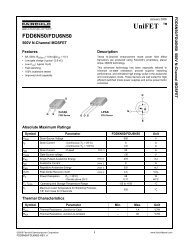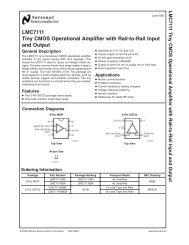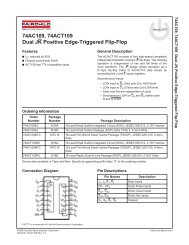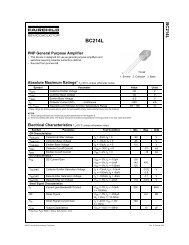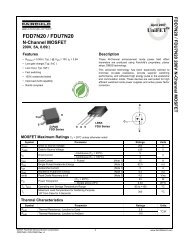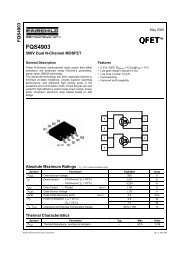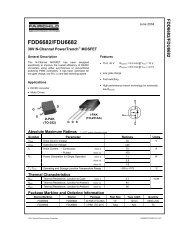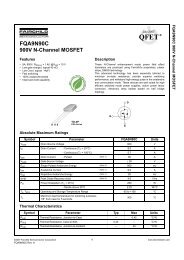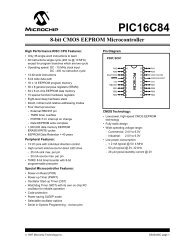LM4702 Audio Power Amplifier Series Stereo High Fidelity 200 Volt ...
LM4702 Audio Power Amplifier Series Stereo High Fidelity 200 Volt ...
LM4702 Audio Power Amplifier Series Stereo High Fidelity 200 Volt ...
You also want an ePaper? Increase the reach of your titles
YUMPU automatically turns print PDFs into web optimized ePapers that Google loves.
<strong>LM4702</strong><br />
Application Information (Continued)<br />
bias point on the amplifier’s input terminal. The resulting<br />
-3dB frequency response due to the combination of CIN and<br />
RIN can be found from Equation (5) shown below:<br />
fIN =1/(2πRINCIN) (Hz) (5)<br />
With large values of RIN oscillations may be observed on the<br />
outputs when the inputs are left floating. Decreasing the<br />
value of RIN or not letting the inputs float will remove the<br />
oscillations. If the value of RIN is decreased then the value of<br />
CIN will need to increase in order to maintain the same -3dB<br />
frequency response.<br />
AVOIDING THERMAL RUNAWAY WHEN USING<br />
BIPOLAR OUTPUT STAGES<br />
When using a bipolar output stage with the <strong>LM4702</strong> (as in<br />
Figure 1), the designer must beware of thermal runaway.<br />
Thermal runaway is a result of the temperature dependence<br />
of Vbe (an inherent property of the transistor). As temperature<br />
increases, Vbe decreases. In practice, current flowing<br />
through a bipolar transistor heats up the transistor, which<br />
lowers the Vbe. This in turn increases the current again, and<br />
the cycle repeats. If the system is not designed properly, this<br />
positive feedback mechanism can destroy the bipolar transistors<br />
used in the output stage.<br />
www.national.com 12<br />
One of the recommended methods of preventing thermal<br />
runaway is to use a heat sink on the bipolar output transistors.<br />
This will keep the temperature of the transistors lower.<br />
A second recommended method is to use emitter degeneration<br />
resistors (see Re1, Re2, Re3, Re4 in Figure 1). As<br />
current increases, the voltage across the emitter degeneration<br />
resistor also increases, which decreases the voltage<br />
across the base and emitter. This mechanism helps to limit<br />
the current and counteracts thermal runaway.<br />
A third recommended method is to use a “Vbe multiplier” to<br />
bias the bipolar output stage (see Figure 1). The Vbe multiplier<br />
consists of a bipolar transistor (Qmult, see Figure 1)<br />
and two resistors, one from the base to the collector (Rb2,<br />
Rb4, see Figure 1) and one from the base to the emitter<br />
(Rb1, Rb3, see Figure 1). The voltage from the collector to<br />
the emitter (also the bias voltage of the output stage) is<br />
Vbias = Vbe(1+Rb2/Rb1), which is why this circuit is called<br />
the Vbe multiplier. When Vbe multiplier transistor (Qmult,<br />
see Figure 1) is mounted to the same heat sink as the bipolar<br />
output transistors, its temperature will track that of the output<br />
transistors. Its Vbe is dependent upon temperature as well,<br />
and so it will draw more current as the output transistors heat<br />
it up. This will limit the base current into the output transistors,<br />
which counteracts thermal runaway.



